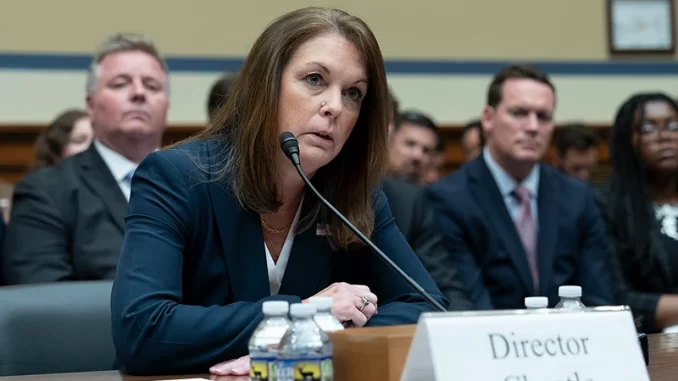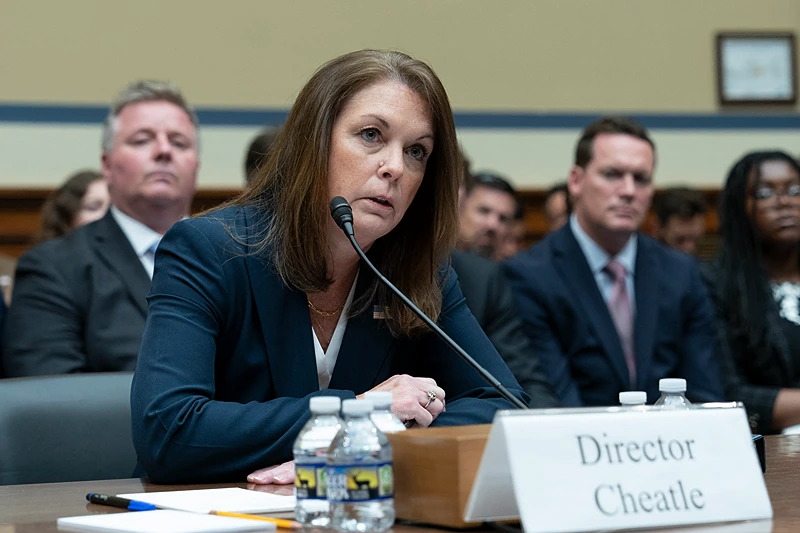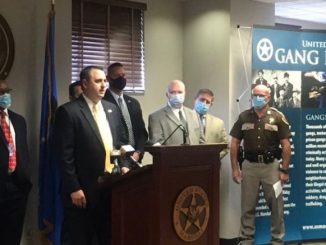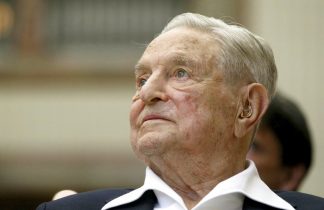

OAN Staff Brooke Mallory
5:37 PM – Monday, August 5, 2024
According to three sources within the Secret Service, former director Kimberly Cheatle and other high-ranking agency officials wanted to “destroy” the evidence of cocaine found in the White House last summer.
Advertisement
However, the Uniformed Division and the Forensic Services Division of the Secret Service resisted the pressure to destroy the evidence.
The sources claimed that on July 2nd, 2023, on a Sunday while President Joe Biden and his family were at Camp David in Maryland, a Secret Services Uniformed Division officer discovered the bag of cocaine. This discovery sparked numerous arguments and discussions in the agency regarding how best to “handle the cocaine.”
The cocaine incident was initially put under investigation by at least one Uniformed Division officer. However, he was removed from the case after he informed his superiors—Cheatle and Acting Secret Service Director Ron Rowe, who was deputy director at the time—that he wanted to adhere to a specific crime-scene investigative protocol.
After the assassination attempt on Donald Trump on July 13th, Cheatle admitted that her agency had “failed” and she resigned under immense pressure from both parties. She also continuously dodged questions from congressional members, which led to Nancy Mace, a U.S. GOP representative for South Carolina, raising her voice in a fiery back-and-forth discussion.
“You’re full of sh*t,” Mace said after hearing Cheatle’s response to a question.
Meanwhile, the president’s son, Hunter Biden, has a long history of partaking in crack cocaine use, as well as cocaine. Nonetheless, he has consistently claimed that he has been sober since 2021. Although the cocaine was found right after Hunter Biden had been staying at the executive house, neither Joe nor Hunter were present when it was discovered.
While working on Vice President Joe Biden’s security detail, Cheatle grew very close to the Biden family. In fact, Biden nominated Cheatle for the director position in 2022, partly due to her close relationship to First Lady Jill Biden, Real Clear Politics reported.
Cheatle was well aware that the cocaine would cause a media frenzy when it was first reported, with accusations linking it to Hunter Biden.
A slew of revolving images of Hunter smoking crack cocaine during the height of his drug addiction went viral for a second time after the event, and Republican officials like Nikki Haley openly accused the Secret Service of knowing whose cocaine it was and of trying to hide it.
The drug-fueled images of Hunter were taken by himself, and they were found on a laptop that he purportedly left at a computer repair shop in 2019. He never came back for the laptop after 90 days, so the shop’s owner, John Paul Mac Isaac, took it upon himself to go through it. Isaac had asked Hunter to sign a form that would give him permission to seize his property if he had not come back to pick up his laptop after 90 days from the time of purchase. However, Hunter’s attorneys have tried to argue that the verbiage on Isaac’s customer form did not give him the right to the data on the hard drive.
Typically, there would be no news regarding the discovery of cocaine or any other illicit drugs at the White House compound or in the vicinity of the first family and their employees. That’s because, according to three sources in the Secret Service, illegal drugs or other “contraband” found in the White House, personal residences, or other private areas of the president, his family, and White House staff would simply be disposed of by the president, first lady, or family members’ protective Secret Service details, the innermost ring of protective agents assigned to the first family.
However, the bag of cocaine was not discovered by a member of President Biden’s usual detail two days prior to July 4th. Rather, while making routine rounds of the White House complex, a member of the agency’s Uniformed Division—tasked with guarding the venues and facilities used by presidents and other agency protectees—discovered the small drug bag.
Throughout the initial weeks of media coverage of the incident, the precise spot where the officer discovered the bag was changed multiple times, with a number of different news outlets claiming to have spoken to White House insiders or employees. According to early reports, a reference library was where the cocaine was found. However, subsequent reports stated that it was in a “work area” of the West Wing, which is connected to the mansion that holds the Oval Office, press briefing room, cabinet room, and residences for the president and his family. Nonetheless, CBS News cited law enforcement officials who claimed that it was actually discovered in an area where visitors and employees of the White House store their phones.
“An official Secret Service statement, issued at the conclusion of the agency’s internal investigation into the cocaine discovery, said a Uniformed Division officer found the bag in a ‘vestibule leading to the lobby area of the West Executive Avenue entrance to the White House,’ a well-trafficked area used on the weekend for White House tours. That statement was released on July 13th, eleven days after the cocaine’s discovery,” according to Real Clear Politics.
The official who discovered the bag containing white powder initially marked it as possibly hazardous, fearing that it might contain ricin or deadly anthrax.
Normally, an investigator from the Technical Security Division (TSD) would be sent to the scene. These investigators are capable of identifying various hazardous materials and explosives and working swiftly to remove or detonate them. They occasionally wear hazmat suits. However, on a Sunday night during a holiday weekend, the TSD investigator was not contacted. Instead, a Secret Service agent or officer contacted the District of Columbia Fire and Emergency Medical Services Department, which ordered the evacuation of the White House complex while the white material was analyzed on the premises.
The Secret Service leaders swiftly switched to crisis communications mode after realizing that they could not conceal the discovery from the press as they were involved in the evacuation. Meanwhile, the white powder and its packaging were handled like evidence and forwarded to the National Biodefense Analysis and Countermeasures Center of the U.S. Department of Homeland Security, where it underwent another biothreat analysis. There was no dangerous substance detected in those tests either.
Soon after, the FBI’s crime laboratory received the plastic bag and its contents from the Secret Service for analysis of the fingerprints and DNA. Several sources said that the agency screened the DNA sample against national criminal databases and “got a partial hit,” citing private statements made by a special agent in the Forensics Services Division who oversaw the vault housing the cocaine evidence.
Although the term “partial hit” is imprecise in this particular context, it typically refers to a situation in which law enforcement discovers DNA that matches “a blood relative of a limited population.”
“The Congressional oversight committees need to put White under oath and confirm the ‘partial hit,’” one of the sources told reporters. “Then the FBI needs to explain who the partial hit was against, then determine what blood family member has ties to the White House or what person matching the partial hit was present at the White House that weekend.”
Additionally, federal prosecutors revealed that last year, when the president’s son was carrying his firearm, there was cocaine residue discovered on the pouch. In January, they also asked a judge to reject Hunter Biden’s attempts to have the gun charges against him dismissed. The president’s son was eventually found guilty by a 12-member jury in June on all charges pertaining to the purchase and possession of a firearm during his crack cocaine addiction. Hunter also lied on the federal forms.
The insiders went on to claim that Secret Service chiefs specifically chose not to run more DNA matching searches or speak with the hundreds of employees working in the White House complex due to pressure from Cheatle and other senior agency officials.
“That’s because they didn’t want to know, or even narrow down the field of who it could be,” a source stated. “It could have been Hunter Biden, it could have been a staffer, it could have been someone doing a tour—we’ll never know.”
“On July 12th, the Secret Service received the FBI’s laboratory results, which did not develop latent fingerprints, and insufficient DNA was present for investigative comparisons,” said Secret Service spokesman Anthony Guglielmi said. “Therefore, the Secret Service is not able to compare evidence against the known pool of individuals.”
“There was no surveillance video footage found that provided investigative leads or any other means for investigators to identify who may have deposited the found substance in this area,” he continued. “Without physical evidence, the investigation will not be able to single out a person of interest from the hundreds of individuals who passed through the vestibule where the cocaine was discovered.”
When precisely Cheatle and other high-ranking officials attempted to get the Forensics Services Division to destroy the evidence is unknown. According to two people within the Secret Service, Matt White, the supervisor of the vault, got a call during the investigation from Cheatle, or someone speaking on her behalf, urging him to destroy the cocaine bag because agency authorities wanted to close the case.
“Protocol is, whether you act on the [DNA] hit or not, we still have to maintain evidence for a period of up to seven years,” the source told reporters. “It became a big to-do.”
“A decision was made not to get rid of the evidence, and it really pissed off Cheatle,” another source in the Secret Service said.
Stay informed! Receive breaking news blasts directly to your inbox for free. Subscribe here. https://www.oann.com/alerts
Advertisements below






Be the first to comment